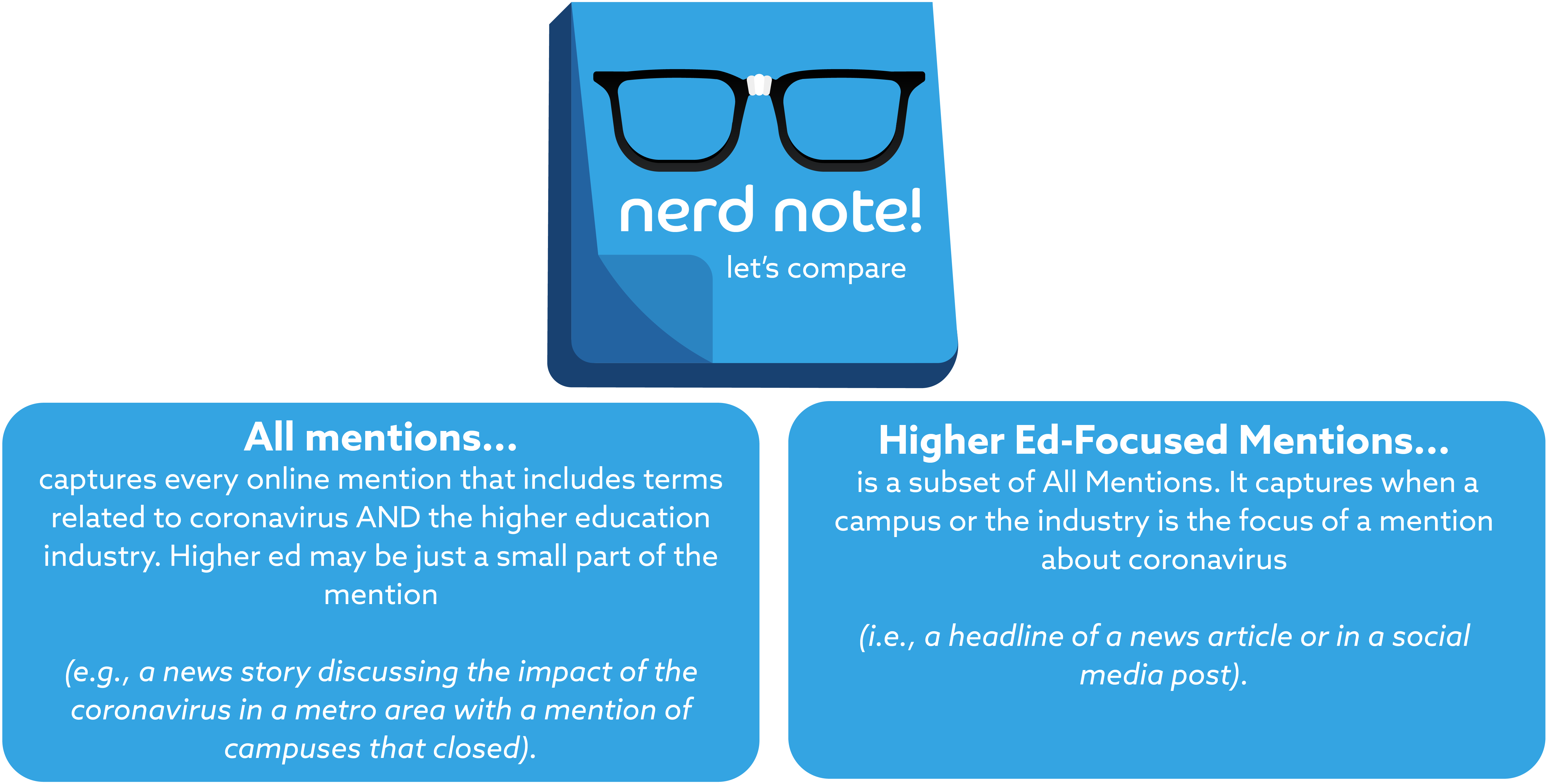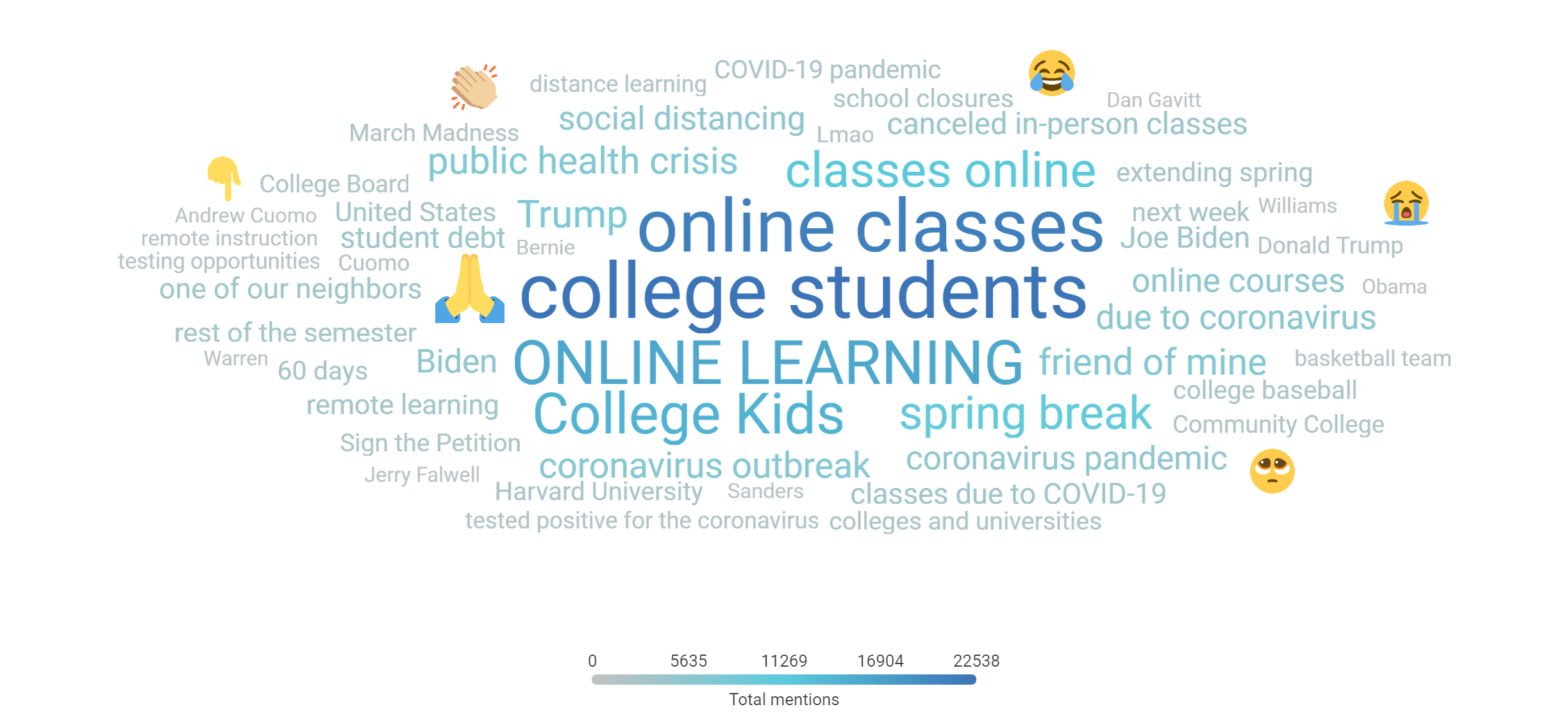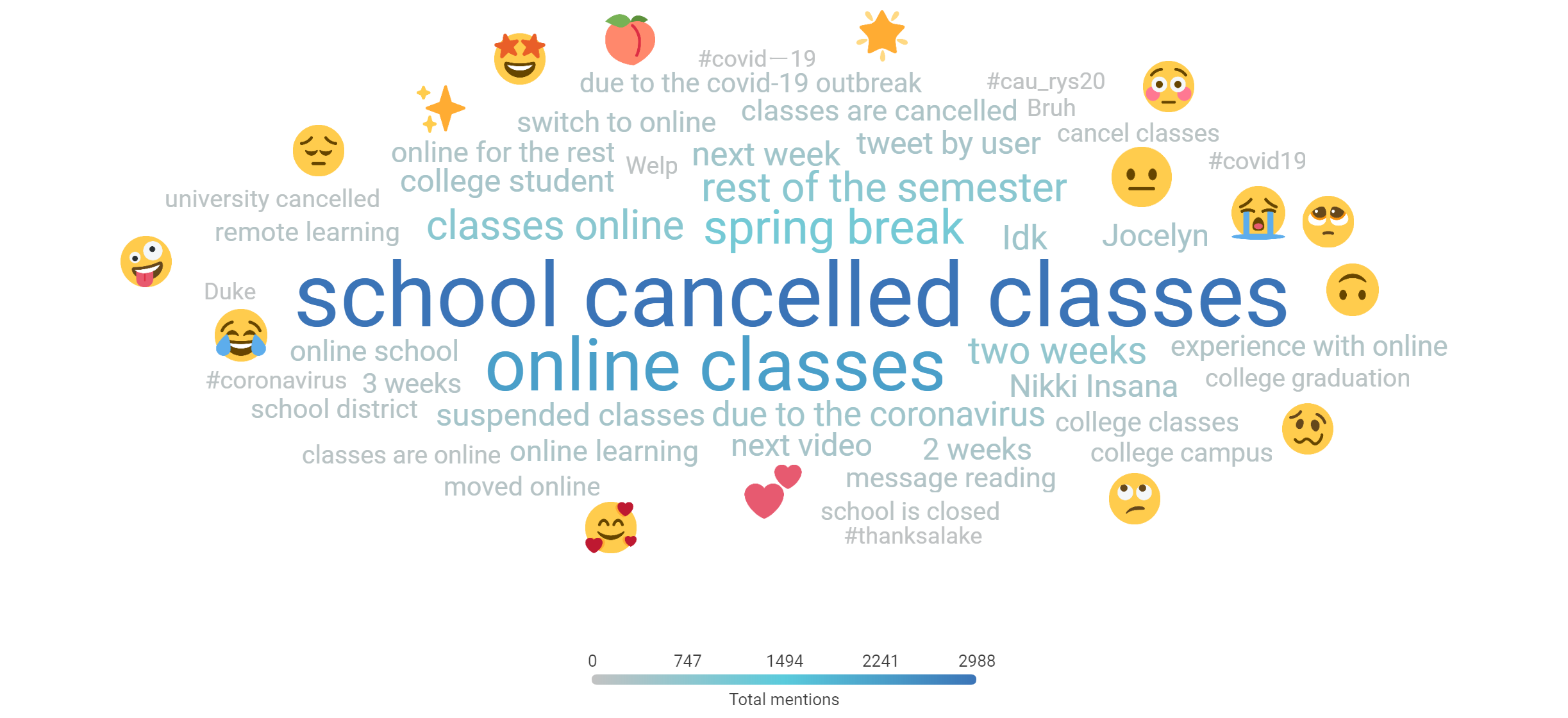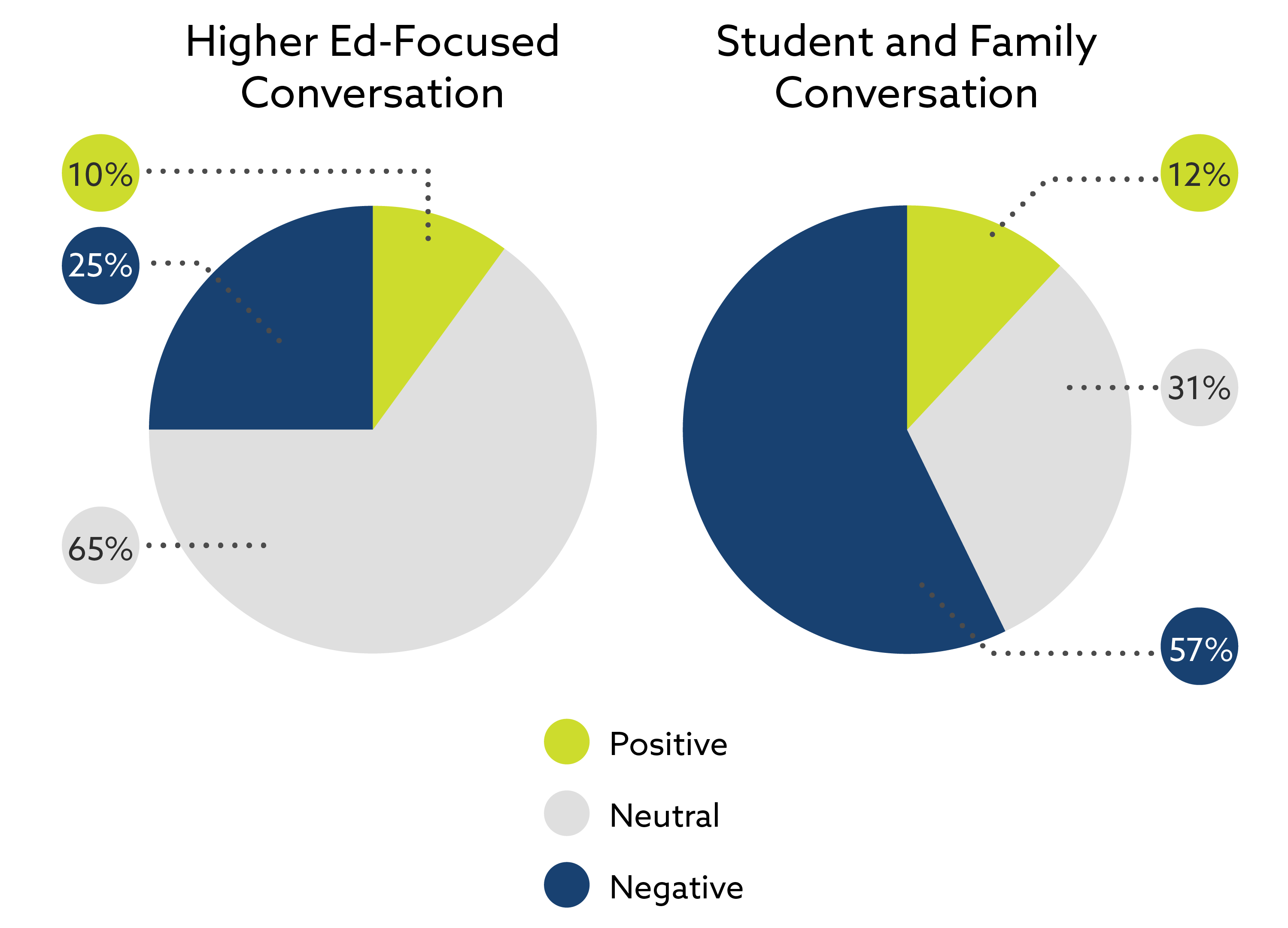Coronavirus Higher Education Industry Briefing: March 17

Word of Mouth Drives Both Information and Misinformation with Students
Today’s briefing analyzes publicly available online conversation about coronavirus and higher education from March 13–16. In this analysis of volume, topics, sentiment, and key audiences, we highlight the most popular topics, continued negative sentiment, concerns of parents and admitted students, and surprising trends of where students discussed the issue online.
If you’d like to receive each Briefing in your inbox as soon as we publish it, sign up at info.campussonar.com/covid19. You can also review all prior Briefings. Because of the changing nature of social media data and our understanding of the conversation, each briefing covers a distinct point in time. Comparisons from briefing to briefing may be helpful, but we can’t draw correlations like we could if we were using other datasets such as surveys or historical social media data.
Conversation Volume has Settled, for Now
Overall volume was lower than last week (March 9-13) when closing announcements were made, but there were still close to a million online mentions in the last four days—nearly 984,000. Although it’s too early to tell, we may settle into a predictable pattern with less conversation on weekends and more on weekdays. It will be interesting to see if that pattern holds as most of the country self-isolates for social distancing. Right now, “less conversation” may mean about a 50 percent decrease, which still leaves a significant amount of weekend conversation.
We know we’ll always miss some conversation (e.g., mentions that include only campus nicknames without the words college or university), but as we observe language patterns, we’ve seen an emergence of rona and related terms referring to the virus. We’ll update our query to include those mentions for this Friday’s Briefing.
28 percent of all mentions were higher ed-focused.

Social Media Remained the Dominant Source of Conversation
82.5 percent of higher ed-focused conversation occurred on social media, with another 8 percent on forums and 6 percent on news sites. The conversation distribution by content source doesn’t vary much for All Mentions compared to Higher Ed-Focused mentions. Of all online news mentions including higher education in their coronavirus coverage, 33.5 percent focused on higher education in the headline of the story or a story’s URL.
Online Learning and COVID-19 Testing Were Popular Conversation Topics
The following word cloud displays the most common words, phrases, and emojis from the 276,000 higher ed-focused mentions in this analysis.

College students and online learning or online classes are mentioned in popular posts about corporations offering free internet or other services to students during this time, such as this tweet about Spectrum’s offer for free services with nearly 80,000 interactions, posted on Sunday by a high school student. (Note that messages like this one that turn text into images are inaccessible for people with screen readers without appropriate alt text.)
Many of the coronavirus-related terms have started to relate to testing. As COVID-19 testing has become more prominent, campuses were mentioned when community members tested positive or when university hospitals were involved in testing or treatment. Late on Monday, testing opportunities started to emerge as a topic after the College Board’s announcement that May academic testing would be cancelled. Over time it will be important to understand the nuances in conversation about “testing,” whether it’s related to the virus or academic testing.
There is discussion from students and campus community members about social distancing, both for people who remain on campus and those who have left. Time constraints didn’t permit a deep dive into this topic, but it appears students are discussing social distancing in an appropriate manner, and sometimes expressing displeasure at classmates who continue to congregate in large groups over spring break.
Personal Conversations Were Overwhelmingly Negative
While the higher ed-focused conversation is 25 percent negative (much higher compared to pre-coronavirus conversation), first-person, personal conversation from students and their families is even more so—57 percent is negative. Keep this in mind when considering the working conditions of campus staff who spend their days responding to students, parents, and the public on social media. The overwhelming sentiment directed to them is likely to be negative.
Hidden Voices: Student, Family, and Admitted Student Conversation
When the conversation is this large, it’s hard to find the individual voices. While almost 210,00 individual accounts are contributing to higher ed-focused conversation, only 9 percent of the mentions are first-person accounts from individuals who reveal an affiliation with a campus. These hidden voices represent lived experiences that provide valuable insight as you craft your communication and service delivery.
We know people tend to believe “people like them” when they’re seeking information. This is proving true in coronavirus conversation.
Student Perspectives Spread Via Word of Mouth
The largest audience we found is students, but there is also insightful conversation from parents and admitted students. Students are discussing this issue on Tumblr more than any other source in our analysis—53 percent of the student conversation we identified was on Tumblr. (Remember that due to data access restrictions, we aren’t including Facebook, Instagram, Snapchat, TikTok, or LinkedIn in any of our analysis. Your campus social media manager is the best source of information regarding conversation on those networks.)
Tumblr has been largely ignored by most higher education social media managers for the last year or two. None of the go-to studies indicate it’s a popular network with students, and the Pew Internet Research Center doesn't ask about Tumblr in its ongoing survey of social media use. However, it appears at least some students are using the network regularly, and the like/reblog functionality is amplifying messages.
The most popular Tumblr message we identified was actually a point of misinformation. A Tumblr user who identifies as an international student studying at a U.S. campus posted on Wednesday, March 11, that international students should not return to their countries or they’d lose their F-1 visa. Despite updating the post on March 13 when the user received updated information from their campus, the post can be confusing and anxiety-inducing to the casual reader, and it’s been shared almost 10,000 times. (COVID-19 guidance for the Student and Exchange Visitor Program is available here.)
After excluding shares of that message from our student conversation sample (it was 17 percent of those mentions), we can examine the other topics students are discussing.

Students are using online classes, rest of semester, or cancelled classes to add context to the experiences they’re sharing online. The existence of relatively positive emojis in this conversation represents a mixture of sarcasm, stating what they’re grateful for amidst this change, encouraging others to stay strong, and finding joy in having unexpected time to do more things they’re passionate about. One thing they have more time for is creating more content for Instagram and YouTube, so it will be interesting to see what sort of content is created and shared while students are home, and if that impacts admitted students’ perceptions of campuses during decision time. Which brings us to...
Admitted Students Are Worried About Making Decisions Without College Visits
While the volume of admitted student conversation we’ve identified is much less than student conversation, a theme is emerging. Admitted students want to know how they’ll decide which college is right for them if they’re unable to visit this spring. Some are asking this question rhetorically on Twitter, while others go to forums like Reddit and College Confidential to directly ask for advice. A student at Wellesley College offered help to the /ApplyingToCollege subreddit on Monday with an AMA (i.e., Ask Me Anything) about her experience being sent home.
A high school student posted on College Confidential (still a popular site, averaging about 4 million visits per month) with the subject, “How to commit to a college you haven't seen (due to COVID-19).” Answers they received included:
- Just use college guides and campus websites to make your decision; the “feeling” you have on a campus visit doesn’t matter.
- Rely on online forums dedicated to those colleges.
- Watch the “day in the life” videos from YouTubers on the campuses you’ve been admitted to.
- Choose the campus that responds best to the coronavirus.
We may need to consider that authentic student representations of the college experience will have even more impact on admissions decisions this year than they have in the past.
The Most Common Parent Emotion Is Grief
More than half of the emotional posts from students express anger, and parents are most likely to express sadness. Their sadness is largely rooted in the grief they’re experiencing when they think about their children missing important milestones like graduation. This conversation is occurring largely on Twitter. A Monday night tweet from popular online humorist Wendy Aarons captures this sentiment well.
My son Sam was born 3 weeks after 9/11. The nurses had one eye on CNN when I was in the delivery room. Now he’s a senior & COVID19 means he probably won’t have prom or graduation. Forget college new student day. But this I know without a doubt: his generation is strong as hell.
— Wendi Aarons (@WendiAarons) March 16, 2020
Summary and Recommendations
Although conversation volume on this issue may be stabilizing, it’s far from gone. We’re likely entering a period of “new normal” with sustained conversation about the coronavirus and related operational changes in higher education. Social media remains a dominant source of conversation, with online learning and coronavirus testing as popular topics over the last four days. Social distancing is also emerging as a conversation topic.
Students are spreading information and misinformation through social networks, including on Tumblr. Admitted students are worrying about how to make decisions without campus visits, while parents are grieving the loss of their children’s milestone experiences.
Here are some recommendations for action.
- Staff Social Media Appropriately. The new normal for social media is increased conversation volume. And for now, that volume comes with overwhelmingly negative sentiment. Ensure your main social media accounts are staffed appropriately for engagement. This could mean multiple staff (appropriately trained) who rotate responsibility in shifts. That shift may need to include weekends, which should be factored into their other expectations during the week. Considering that more than half of their interactions may be with individuals expressing negativity, ensure they have the appropriate support system (breaks, mental health) to function in a challenging environment.
- Word of Mouth Matters. Unfortunately, official campus communication is not the only source of information for your students, families, and applicants. Unsanctioned updates from well-meaning staff will be screenshotted and posted to Tumblr. Rumors will be relayed as fact. In the absence of a campus visit, admitted students will seek out unfiltered content from students on YouTube, Instagram, Reddit, and college forums to inform their decisions. Campuses should not only keep their eyes and ears open to capture WoM conversation, they should be considering ways to empower students (tour guides, RAs, involved students) to create college-focused content during this time.
- Support Grieving Parents. As you work through alternatives for graduation and other spring campus traditions, consider how you communicate with students and their parents. Can you support their grief and provide other milestones for them to look forward to? Is there a way to involve them in the solution? Don’t forget their voices and feelings.
The Coronavirus Higher Education Industry Briefing is new territory for Campus Sonar. If you find it valuable, please let us know (tweet us at @CampusSonar, email info@campussonar.com, or comment on this post).
Do you have additional questions about the conversation you’d like us to consider for a future briefing? Let us know.
We’ll be back on Friday with our next briefing. We’re expecting some additional insights as we add emerging slang like ’Rona to our query and try to focus on sites like YouTube. Until then, settle into your home office (or keep your distance from on-site coworkers), and let us know if you’re binging anything interesting on Netflix.


